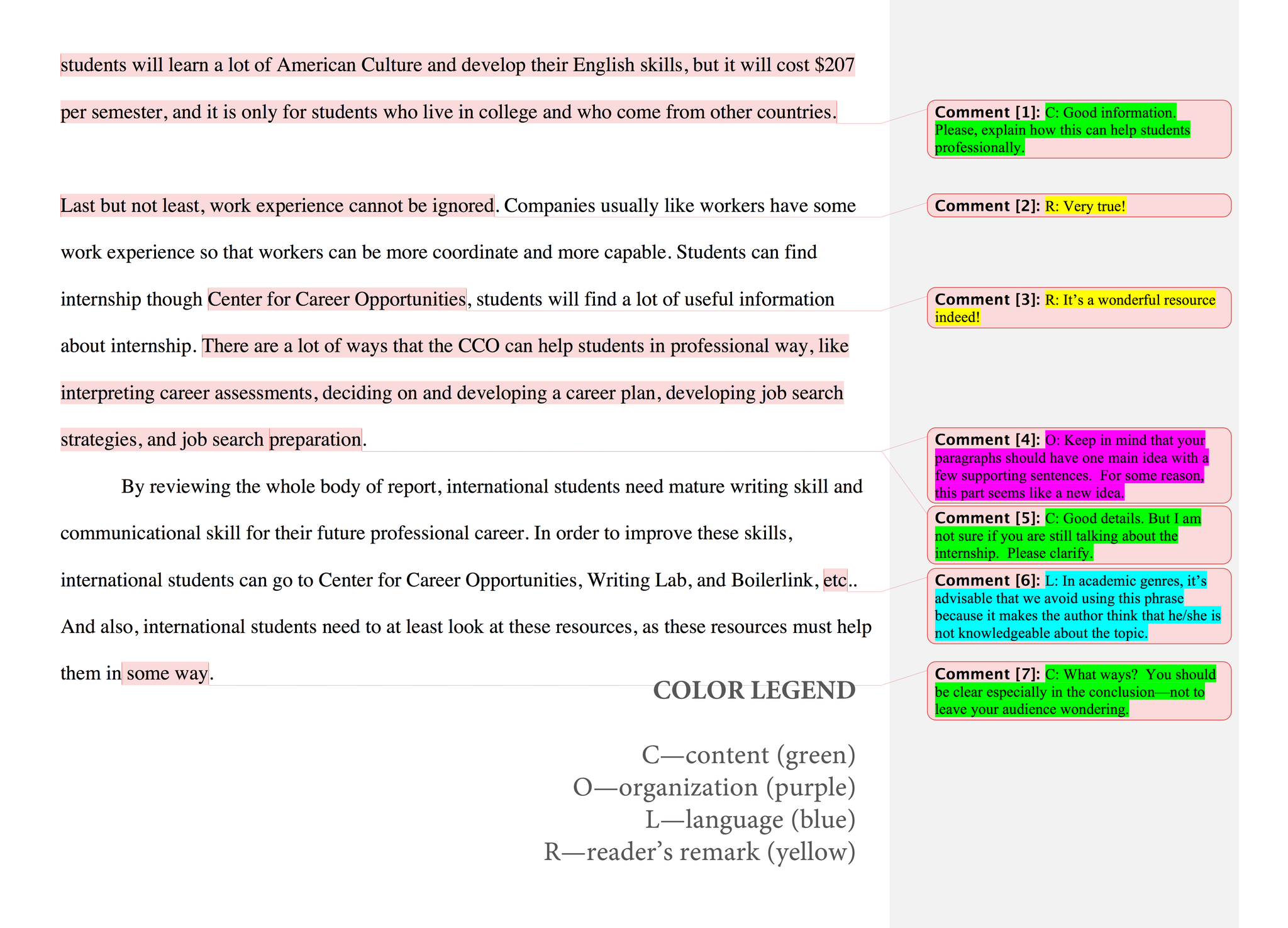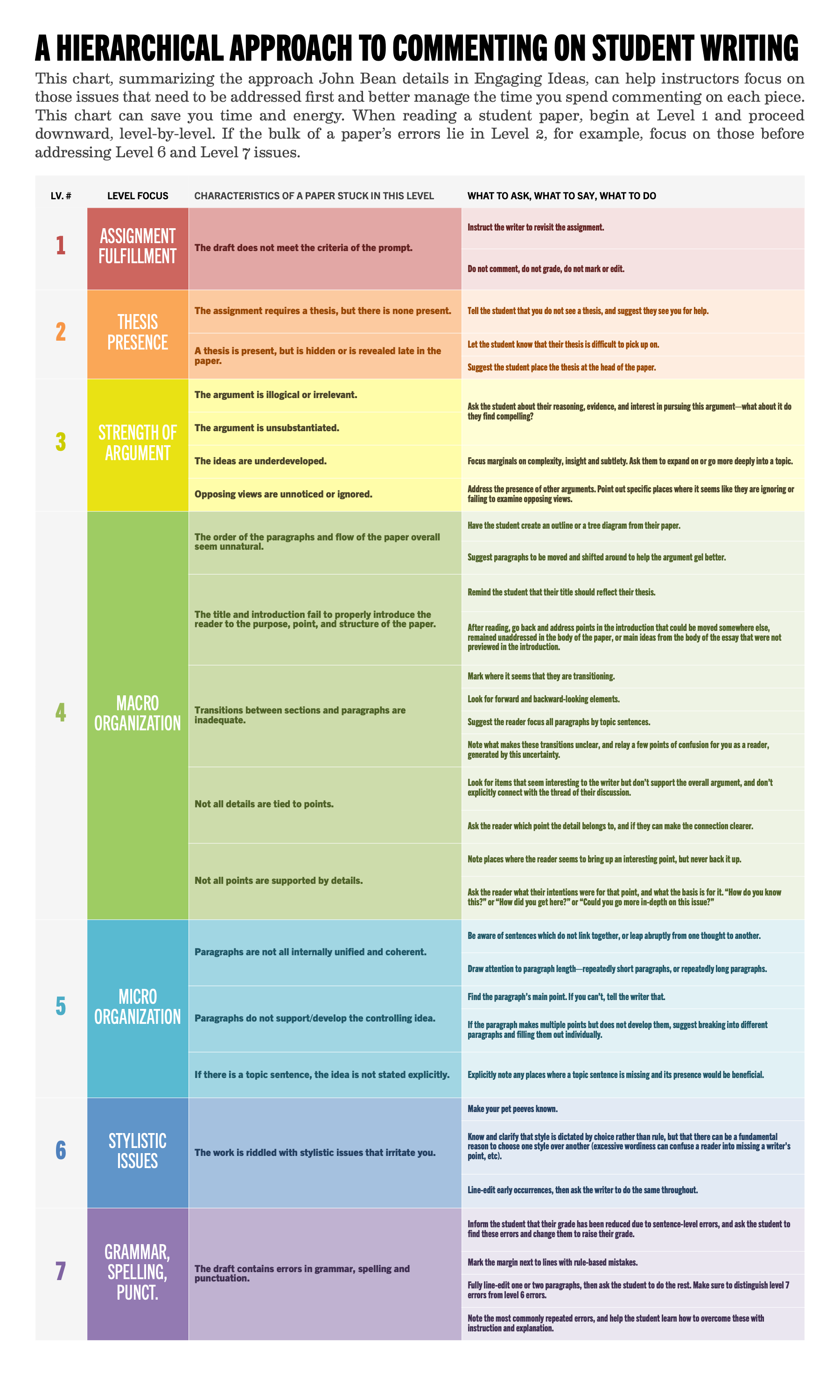Asynchronous appointments can be intimidating because the writer is not in the appointment to help drive the appointment. These are general strategies tutors can use to help guide their work in asynchronous appointment modalities without the writer in the room.
👏 Use an Encouraging Tone
Finding an appropriate tone for your comments is crucial to providing excellent written feedback. Since you have no face-to-face contact with your writer, they have no vocal or physical cues to interpret your feedback with. As such, carefully consider how someone without these cues will read your comments. Use your fellow peer writing tutors as sounding boards if you’re wondering about a particular comment. To avoid coming off as short or rude, consider the following strategies in order to build rapport in a professional yet friendly way.
🎯 Be Clear & Specific
Shorthand such as “awkward” (or even worse, “awk”) isn’t helpful to writers who want to revise as they are left guessing what you are suggesting they change. This shorthand can also come across as appropriating their work rather than offering and explaining suggestions. The most helpful peer writing tutors point out specific ideas, phrases, organization, and so on, that are effective or ineffective, and then provide the writer with explanations and suggestions for revision. The inclusion of an explanation for why the points you make are important helps to make your feedback transferable to more situations than that specific instance.
Avoid using sarcasm and use jokes with caution. While these tools can sometimes be effective in face-to-face conversation after you’ve built rapport, you cannot predict the tone with which a writer will read your written feedback. It is important to be friendly with your writer but also maintain a level of professionalism and tact.
💁 Be Conversational
Write comments that mirror how you would talk to the writer, but remember that no vocal inflection exists in your writing. Emoticons, when used appropriately, can help you establish a friendly tone. Don’t overwhelm the writer with smiley faces in every comment, but feel free to use them a few times to help convey a friendly tone. If it would be appropriate, relevant, and helpful, feel free to refer to your own writing experiences.
🛋️ Be a Reader
Foregrounding your experiences as a reader will help you to contextualize your praise and suggestions by articulating your authentic experience processing the draft. Foregrounding your reading allows you to make comments on the writer’s draft not from a position of authority that has all the right answers but from the position of a knowledgeable reader whose questions, uncertainties, and reactions may be shared by the writer’s intended audience.
By foregrounding your experiences as a reader, you avoid evaluative language and instead frame your praise and suggestions in terms of helping the writer understand where they have and have not communicated their ideas effectively to you. As Nancy Sommers (1982) explains, “comments should point to breaks in logic, disruptions in meaning, or missing information” (p. 155). Comments can also point to places the writer has persuaded you by providing believable evidence, for example, or led you through their main points in the way you were expecting.
Sample Comment Foregrounding Experience as a Reader
As I read your discussion section, I was struck by how you consistently provided statistical evidence from your survey research to support each claim you made. By doing this and by presenting the statistical analysis in charts that were easy for me to read, it built up your credibility with me as I read the remainder of your article.
🥳 Offer Positive Feedback
Remember to approach drafts by asking, “What’s working well?” rather than only looking for where the writing falls short. Identifying moments you find effective and explaining why they are effective can help writers repeat and build on those strengths in the current project and in future projects. You help writers develop as writers by taking the time to point out what is effective in their work—a novel idea, a well-structured paragraph, an aptly chosen word, or the beginning of powerful insight. Stay away from evaluative comments (e.g., “That’s a textbook perfect thesis!” “Good job!”).
Remember to be honest and specific in your critique. As former tutor Colin Sato advises in his tutoring philosophy, “it’s very obvious that incorporating meaningful praise into one’s tutoring entails more than just saying good things about a person’s writing: we have to say good things and mean them.” Praise can provide motivation for the process of revision and can help you avoid overwhelming writers with criticism.
Sample Specific Positive Feedback
I found your overall framing—that the best leaders are servants—clear and compelling. I also appreciated your description of and reflection on your experiences tutoring at Oakton CC!
🛠️ Offer Constructive Feedback
Peer writing tutors don’t do writers any favors when they tell them that they have a “great first draft” if the writing actually would benefit from significant revision before, for example, it can be turned in to an instructor. Point out areas where you, as an authentic, engaged reader, felt lost or confused as you read the project. Then, be sure to offer a couple of concrete options for how the writer might address the issue you raised. Using specific details not only can help your writer understand their writing’s weak or unclear features, it also can help them believe in the strengths you point out in your feedback elsewhere.
Sample Specific Constructive Comment
One overarching thought on your introduction: I found the ordering of ideas a bit hard to follow. I genuinely think all the ideas in the paragraph are clear and relevant, but I wondered as I read this if you putting your own formerly-limited understanding of leader=boss earlier in the paragraph might be stronger? You might even replace your first sentence with this one and proceed from there? (That way you avoid the "many people..." conceit in the first sentence, something I imagine some readers might respond to with a question like, "They do?")
➡️ Provide Directive Feedback
At certain times you might feel that the writer would benefit from a more directive approach to a particular concern. You may deduce when a writer is unaware of a certain convention when you identify a recurring pattern. Some commentary will require a more direct explanation of the conventions of writing for a particular discipline or a grammatical principle.
When being directive, you should still—under any circumstances—avoid appropriating the writer’s work. Writing Center Tutors should never start making changes in a text for the writer.
Instead, for example, create a model sentence, explain a grammatical principle, or provide a few different solutions that would remedy the issue. For subsequent iterations of the same issue, consider highlighting them, letting the writer know what the highlighting means, and having the writer refer back to your modeling for ideas on how to address these subsequent iterations. For example, you can tell a writer, “From here on out, orange highlights will indicate other places where your citations aren’t formatted in MLA style. You can refer back to this comment for an explanation of MLA format and options you can apply to those other cases as well.”
Sample Directive Comments
I'm wondering if you might more directly make the case that you should be accepted for/are a strong candidate for the Leadership Tour given your insight about leadership+service and the experiences that are forthcoming in the essay. Like basically a thesis statement that ties together your big theme of this essay, the examples you provide, and the reason you're writing the essay.
↪️ Provide Non-directive Feedback
Non-directive comments in written feedback are an opportunity for tutors to engage in a dialogue with writers in the hopes of eliciting more information about a topic without telling the writer what to do.
You can get writers actively involved in their writing and revising when providing written feedback by asking questions about the document’s intended audience like, “would your intended audience need a more basic definition?” to frame your feedback or by using suggestions and phrases like “you might consider…” In either of these cases, be sure to explain why you are having these particular questions and why you are making specific suggestions. For local as well as global concerns, ask questions that get the writer thinking, highlight patterns, and provide writers with insight into a reader’s reactions to the text.
If you choose to ask open ended questions, be sure you clarify why you are asking each question so as not to confuse the writer. Are you confused by the meaning, assuming a different organizational scheme based on the thesis, understanding the project differently, playing devil’s advocate, etc.?
Sample Non-Directive Comments
I wondered as I read what researchers have found the emotional and mental side effects to be? I can only imagine how intense it must be for anyone to experience, of course, but I wondered if there’s definitive research?
📚 Provide Resources
Sometimes you may find that you’d like to give more explanation and detail than you can reasonably provide without overwhelming the writer or focusing too much on lower-order concerns. Providing outside resources for writers in the summary letter or marginal comments can help you give writers the tools and information they need to succeed, demonstrate your ethos as a peer writing tutor, and save you from complicated or long-winded explanations.
Sample Comment Providing Resources
Commas: As identified above, I’ve noticed a pattern with missing commas following introductory words or phrases, and I hope you are seeing the trend based on my comments. In this sentence, can you identify where the comma should be placed? Consider using the explanations provided above, and check out this website for more examples and information: http://www.quickanddirtytips.com/education/grammar/what-is-a-subordinate-clause.
🎨 Use Color Coding
Color coding allows both writer and tutor to see the frequency and disbursement of a trend within a draft. You provide the writer with a visualization of their feedback that can make the feedback easier for them to interpret.
Color coding can help you avoid commenting on every instance of an agenda item and instead highlight certain specific instances, making it clear for the writer where the issue is manifesting within their draft. Color coding can also be effective for distinguishing effective and ineffective aspects of their draft related to a particular agenda item. For example, you might highlight places that a writer defends their thesis in teal and highlight places a writer refutes their thesis in green.
Sample Color Coding

When color coding, remain consistent and avoid overusing it and potentially overwhelming the writer. Use colors with positive connotations (so no red), and use colors that can be easily distinguished from one another (so avoid using both blue and purple). In the example above, the tutor used color coding and explained what the colors represent in the “color legend.”
🛕 The Hierarchy of Concerns
When working on a written document tutors are encouraged to keep Bean’s (2011) hierarchy of concerns in mind to help establish agendas and provide collaborative feedback. The hierarchy of concerns helps tutors discern the different skill sets writers may or may not be struggling with, and gives tutors an actionable framework for addressing these skills.
Bean’s (2011) Hierarchy of Concerns
To help you discern what to focus on first and/or in the time you have allowed for your written feedback appointment, Bean (2011) offers a “hierarchy of concerns”:
- Does the draft follow the project requirements?
- Does the draft address a problem/question? Does it have a thesis?
- What is the overall quality of the writer’s ideas/argument?
- Is the draft effectively organized?
- Does the draft effectively manage old and new information?
- Is the draft free of errors in grammar, punctuation, and spelling?
- Is the draft free of stylistic problems?
Writers benefit most from addressing global concerns before more local ones.
Global concerns, generally speaking, require more revision and often involve large sections of the text.

Global vs. Local Concerns
There are times when this won’t be the case. For instance, if the content of the sentences is incomprehensible because of a lack of punctuation, then that could take a higher priority within the feedback.
Overall, the topics that you prioritize in your feedback will be a collaborative process between what the writer is looking for and what you determine will have the biggest influence on their writing as a whole.
When a writer requests in the appointment form that you focus on specific aspects of their draft, take that request into account as you develop the collaborative agenda for the appointment. You may agree with the elements the writer asks you to focus on, or you may find the writer explicitly invites you to provide feedback on whatever you think is important or relevant. After considering the writer’s requests and reading through the draft, you may feel there are other concerns that should be addressed that the writer didn’t specifically ask for feedback on. For example, a writer may request feedback on “organization,” but their draft doesn’t fulfill all of the requirements of the provided assignment prompt. In this case, you should focus your time first on responding to the more high-impact, global issues about fulfilling the assignment prompt, then focus on organization if time allows.
🧑🔧 Grammar & Mechanics
Writers often contact the Writing Center with concerns about grammar or mechanics in their writing. Addressing grammar and mechanics in written feedback appointments may sometimes seem daunting, particularly in projects that have many sentence-level concerns. Approach this type of feedback the same way you would other aspects of a project—by foregrounding your experience as a reader.
You should not copyedit the writer’s project, nor should you comment on every error. Rather, look for patterns of error and prioritize your feedback on those issues that obscure meaning or confuse you as a reader. Harris and Silva advise, we “need to distinguish between errors that will interfere with the intended reader’s understanding of the text (global errors) and those that will not (local errors) and to give priority to the former” (526).
Keep explanations specific, concise, accessible, and accurate. Explain how a revision or correction works to advance meaning. Link to a favorite online source for more detailed explanations to help you stay concise.
Instead of pointing out every instance of an error yourself, use your feedback to encourage the writer to start self-identifying and self-correcting these issues. The first time an issue appears, point out the problem, explain why it is a problem, and if relevant, provide a link to a helpful online resource. You can then highlight subsequent instances of the issue and explain to the writer that they can use the guidelines you provided to fix them. Allowing the writer an opportunity to change and identify their own errors will help to make them stronger writers, instead of working to specifically strengthen this 1 piece of writing.
Mark sentences you find effective at communicating the writer’s meaning to you as the reader. Do so in terms of content, style, structure, diction, or coherence. Writers learn best in the context of their own writing and, by explaining what a particular effective sentence accomplishes, it becomes a model for writers to emulate elsewhere.
Never use the Track Changes feature in Microsoft Word or Google Docs. Track Changes appropriates the writer’s text and is often messy and hard to read.
Sample Comments Addressing Grammar & Mechanics
So when you say “on this stage” the preposition “on” turns the word stage into a physical noun (as in, I’m standing on a stage! Like in a theater). Instead, since you’re discussing a stage in time, I’d recommend a preposition that correlates more specifically to time, like “in” or “during.” For example, you could say “In this stage” or “During this stage.”
I’m not sure I know what the word “feministic” means. Do you mean “feminine”? From the context of the rest of the sentence, the word “feminine” would make sense to me.
Do you mean more than one business possesses this information? If so, this would need to be “businesses’.” You could also use the indefinite article “a” with the singular “business” to clear up the confusion if you prefer that sentence phrasing.
